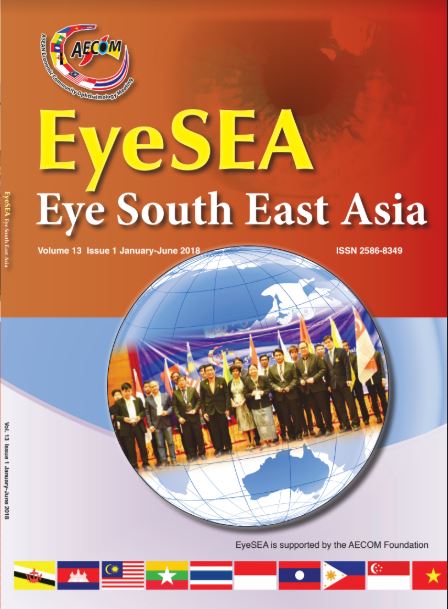Unilateral ptosis as the sole presenting symptom in a case of partial third nerve palsy and bilateral sphenoid sinusitis in a child. paediatric sphenoid sinusitis
Main Article Content
Abstract
Background: There are many causes of pediatric ptosis. However, acute unilateral ptosis manifestation as a result of isolated partial oculomotor nerve palsy involvement caused by sphenoid sinusitis is unusual. This is a diagnostic challenge as we report an uncommonly documented case of bilateral sphenoid sinusitis in a 12-year old boy with unilateral acute ptosis as the only presenting sign.
Case report: The patient presented to our eye department with right upper lid ptosis for one day with no visual impairment, headache, nasal symptoms or other neurological deficit. Diagnosis of bilateral sphenoid sinusitis was made from a contrasted computed tomography of brain and orbit. He underwent emergency bilateral sphenoidotomy by the otorhinolaryngology team, which revealed frank pus from the left sphenoid sinus and inflamed bilateral sphenoid mucosa intraoperatively. After the third day of intravenous Amoxycillin-Clavulonic acid, his ptosis completely resolved and he was discharged without neurological sequelae.
Conclusion: A high level of suspicion is entailed for accurate diagnosis so that correct treatment can be inaugurated. Neuroimaging such as the CT and MRI are excellent modalities to help in such cases.
Conflict of interest: We declare that there are no conflicts of interest.
Article Details
References
2. Ng, Y.S. and C.J. Lyons, Oculomotor nerve palsy in childhood. Canadian Journal of Ophthalmology/Journal Canadien d'Ophtalmologie, 2005. 40(5): p. 645-653.
3. Dankbaar, J., A. van Bemmel, and F. Pameijer, Imaging findings of the orbital and intracranial complications of acute bacterial rhinosinusitis. Insights into imaging, 2015. 6(5): p. 509-518.
4. Giordano, D., et al.., Unusual presentation of pediatric acute sphenoid sinusitis. Acta Bio Medica Atenei Parmensis, 2014. 85(3): p. 271-274.
5. Sethi, D.S., D.P. Lau, and C. Chan, Sphenoid sinus mucocoele presenting with isolated oculomotor nerve palsy. The Journal of Laryngology & Otology, 1997. 111(5): p. 471-473.
6. Tsai, R.K., et al.., Transient third cranial nerve palsy caused by sphenoid sinus aspergillosis. Journal of Neuro-Ophthalmology, 2008. 28(3): p. 239-240.
7. Stefanis, L. and S. Przedborski, Isolated palsy of the superior branch of the oculomotor nerve due to chronic erosive sphenoid sinusitis. Journal of clinical neuro- ophthalmology, 1993. 13(4): p. 229-231.
8. El Mograbi, A. and E. Soudry, Ocular cranial nerve palsies secondary to sphenoid sinusitis. World journal of otorhinolaryngology-head and neck surgery, 2017. 3(1): p. 49-53.
9. Sadashiva, N., et al.., Isolated sphenoid sinus lesions: Experience with a few rare pathologies. Journal of neurosciences in rural practice, 2017. 8(1): p. 107.
10. Wang, Y.-H., et al.., A review of eight cases of cavernous sinus thrombosis secondary to sphenoid sinusitis, including a12-year-old girl at the present department. Infectious Diseases, 2017. 49(9): p. 641-646.


